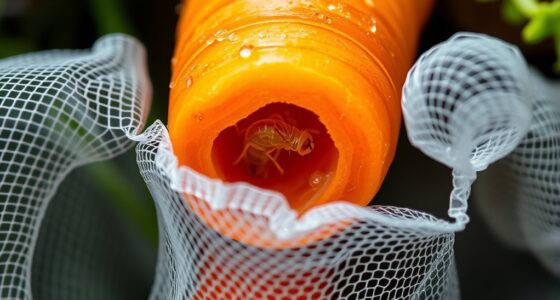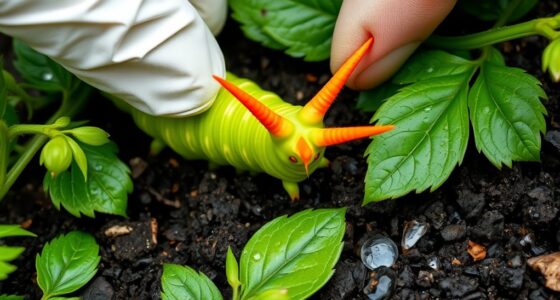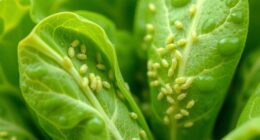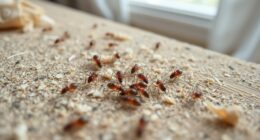To monitor corn silks for earworm eggs and larvae, regularly inspect silk surfaces during early to mid-silking, which is when pest activity peaks. Use a hand lens or magnifying glass to spot tiny eggs or damaged silk tips, and look for silk texture changes indicating larvae presence. Keep detailed records of pest levels and thresholds, and tailor your management strategies accordingly. If you want to improve your monitoring approach, more detailed tips are just ahead.
Key Takeaways
- Inspect silk surfaces daily during 10-14 days after planting for eggs and early larvae.
- Use a hand lens or magnifying glass to detect tiny eggs and larvae among silk strands.
- Look for silk texture changes, discoloration, or silk tip damage indicating egg-laying activity.
- Record pest presence, noting the percentage of silks with eggs or larvae to assess infestation levels.
- Focus monitoring efforts during peak silk emergence to enable timely, targeted pest management actions.
Understanding Earworm Life Cycle and Behavior

Understanding the earworm’s life cycle and behavior is essential for effective monitoring and management. You need to recognize that repeated exposure to insecticides can lead to pest resistance, making control efforts less effective over time. Earworms typically lay eggs on corn silks, and larvae quickly feed on developing kernels, damaging your crop. By understanding their behavior, you can time your interventions more precisely. Crop rotation plays a crucial role in disrupting their life cycle, reducing the chances of infestations. Rotating corn with non-host crops breaks the cycle of egg laying and larval development, helping to lower pest populations naturally. Staying aware of these patterns enables you to implement integrated pest management strategies that are both effective and sustainable. Additionally, understanding the relationship between pest behavior and resistance can help you adapt your control methods to maintain their effectiveness over time.
Identifying Critical Stages of Corn Silking for Monitoring

Monitoring corn silking effectively begins during the critical stages when silks emerge and are receptive to egg-laying by earworms. This window is essential for early detection and management. Silks are most vulnerable when they first appear, typically about 10-14 days after planting. During this period, consider genetic resistance traits that can reduce earworm infestation. Crop rotation also plays a key role by breaking pest life cycles and lowering egg-laying opportunities. Use the table below to identify key silking stages:
| Silking Stage | Earworm Activity | Management Tip |
|---|---|---|
| Early Silking | High egg-laying | Monitor daily |
| Mid Silking | Larvae hatch | Watch for silk damage |
| Late Silking | Larvae mature | Prepare for harvest |
Early monitoring during these stages enhances control efficiency.
Tools and Supplies Needed for Effective Inspection

To effectively monitor corn silks for earworm eggs and larvae, you need the right tools and supplies. These items guarantee your inspections are thorough and accurate. Having the proper equipment on hand makes it easier to detect pests early and take prompt action. Using hydrocolloid technology patches can also help identify early blemishes or infestations on the skin, similar to monitoring pests on crops.
Tools for Inspection Effectiveness
Having the right tools on hand is essential for conducting thorough inspections of corn silks for earworm eggs and larvae. A good hand lens or magnifying glass helps you identify pest eggs and early-stage larvae accurately, improving pest identification and timely intervention. A sturdy flashlight allows you to inspect silks thoroughly, especially in low-light conditions. Keep a notebook or digital device nearby to record pest presence and infestation levels, aiding in tracking patterns over time. Crop rotation tools, such as GPS or mapping software, help plan and monitor field management strategies to reduce earworm populations. Utilizing portable monitoring equipment ensures you can quickly detect pests, make informed decisions, and implement effective control measures, ultimately protecting your crop yield.
Supplies for Monitoring Success
Effective inspection relies on having the right supplies readily available. You’ll need a good hand lens or magnifying glass to spot tiny earworm eggs and larvae on silks. A sharp knife or scissors helps you examine damaged kernels closely. Keep a notebook or spray chart to track pest presence and crop rotation schedules, which can influence earworm populations. Biological control agents, like beneficial insects, may be part of your integrated pest management plan, so having information on their application is helpful. Use small collection containers to gather samples for closer inspection or laboratory identification. Having these supplies on hand ensures quick, accurate detection, enabling timely intervention and better pest control. Proper tools support effective monitoring and promote sustainable practices like crop rotation and biological control. Additionally, understanding projector technology can enhance your ability to present monitoring data visually, making it easier to interpret trends and make informed decisions.
Step-by-Step Guide to Inspecting Corn Silks for Egg Deposition

To effectively monitor for earworm eggs, start by closely examining the silk surfaces on your corn ears. Look for small, pale, or discolored spots where eggs may be attached. Carefully identify these locations to determine if further action is needed.
Inspecting Silk Surface
Inspecting the silk surface is a essential step in detecting early signs of earworm egg deposition. Carefully examine the silk texture, paying attention to any small, shiny eggs nestled among the silks. Look for changes in the silk surface, such as roughness or a sticky feel, which can indicate egg presence. Keep in mind that eggs are often laid where the silk is most exposed, usually near the silk tips. Use a hand lens if needed to see tiny eggs clearly. Consistently inspecting the silk surface helps catch infestations early, preventing widespread damage. Regular monitoring of silk texture and surface details**** is crucial for effective pest management. Remember, a keen eye for the silk texture and surface details makes all the difference in effective monitoring and timely management.
Identifying Egg Locations
When examining corn silks for earworm egg deposition, start by carefully inspecting the tips of the silks where eggs are most likely to be laid. Look for tiny, pale, or translucent eggs clustered on the silk tips. Eggs may be hidden among silk strands, so use a hand lens or magnifier for better visibility. Be aware that fields with genetic resistance may show fewer or more spaced-out eggs, but thorough inspection remains essential. Additionally, practicing crop rotation can reduce egg laying sites over time, helping to manage infestations. Regular monitoring helps identify early egg deposits, so you can target control measures effectively. By accurately locating eggs, you improve your chances of preventing larval damage and protecting your crop’s yield. Using appropriate scouting techniques can further enhance detection accuracy and early intervention efforts.
Recognizing Signs of Larvae Presence on Silks

Recognizing the signs of larvae presence on corn silks is essential for effective pest management. Look for silks that appear chewed or tattered, indicating active feeding. You might also notice small frass (insect droppings) near the silk tips, a clear sign of larvae activity. If you’ve planted pest-resistant varieties, larvae may still find ways to feed, so remain vigilant. Keep an eye out for silk clogging or silk that’s sticky or shriveled, as larvae often invade these areas. Using biological control methods, such as beneficial insects, can help keep larvae numbers in check. Regular inspection can help you catch infestations early and prevent significant damage. Being attentive to these signs allows you to act swiftly and effectively manage earworm populations. Curiosity about pest behavior can improve your ability to identify early warning signs and respond proactively.
Timing Your Monitoring Efforts for Maximum Effectiveness

Timing your monitoring efforts is crucial for catching earworm activity early and preventing significant crop damage. The best time to monitor is when silks are just beginning to emerge, as this is when eggs are laid and larvae hatch. Coordinate your efforts with crop rotation schedules to target fields most at risk. Regular checks during peak silk emergence ensure you don’t miss early infestations. Accurate timing also helps optimize pesticide timing; applying treatments when eggs are present or larvae are just emerging increases effectiveness. Keep in mind that early detection allows for targeted interventions, reducing the need for extensive pesticide use. By aligning your monitoring with key crop development stages, you maximize your chances of controlling earworms before they cause severe damage.
Recording and Interpreting Observation Data

Accurate recording and interpretation of observation data are essential for effective earworm management. By tracking egg and larva presence on silks, you can identify infestation patterns and adjust your strategies accordingly. Pay attention to soil health, as healthier soils can influence plant resilience, and note weather patterns, since warm, humid conditions often increase earworm activity. Keep detailed records of each scouting session, including date, silk condition, and pest counts. Look for trends over time, such as rising egg numbers after rain or specific weather events. This information helps you decide when to intervene and evaluate your management practices. Consistent data collection guarantees you stay ahead of infestations, optimize spray timings, and improve overall crop health. Additionally, understanding GMC tuning techniques can help optimize your equipment for better monitoring efficiency.
Threshold Levels: When to Take Action

Knowing when pest levels reach a threshold that warrants action is essential for effective earworm management. Typically, if you observe 15% or more of silks with eggs or larvae, it’s time to act. Thresholds vary based on your crop rotation practices and pest pressure. If thresholds are exceeded, consider targeted pesticide application to reduce infestation. Crop rotation can also help lower earworm populations over time, decreasing the need for chemical controls. Regular monitoring helps you catch infestations early, preventing significant yield loss. Use this table as a quick reference:
| Pest Level | Action Recommended | Notes |
|---|---|---|
| Less than 15% silks infested | Continue monitoring | Maintain crop rotation practices |
| 15-30% silks infested | Apply pesticide if necessary | Follow label instructions |
| Over 30% silks infested | Take immediate action, consider crop rotation | Evaluate pest management plan |
Stay vigilant to protect your crop efficiently.
Integrated Pest Management Strategies for Earworm Control

Implementing an integrated pest management (IPM) approach is essential for effectively controlling earworms while minimizing chemical use. You can combine cultural, biological, and mechanical methods to keep populations low. Start by practicing crop rotation, which disrupts earworm life cycles and reduces overwintering sites. Consider planting pest-resistant varieties that naturally deter egg-laying and larval development. Additionally, timely monitoring allows you to target treatments only when necessary. Incorporate these strategies to improve control:
- Rotate crops each season to break pest cycles
- Use pest-resistant corn varieties for added protection
- Employ targeted scouting to identify early infestations
Tips for Maintaining Consistent Monitoring Throughout the Season

Maintaining consistent monitoring throughout the season requires establishing a routine and staying vigilant. Regularly check your corn silks for eggs and larvae, especially during peak pest activity. Incorporate crop rotation to reduce earworm populations and disrupt their life cycle. Healthy soil supports strong plant growth, making silks less attractive to pests and easier to observe. Keep detailed records of pest sightings and monitor patterns over time to identify trends. Set specific days each week for inspection to build a habit. Also, make certain your soil health practices—like cover cropping and proper fertilization—encourage robust plants that can better withstand infestations. Vertical storage solutions can help organize equipment and supplies needed for regular monitoring. Consistent vigilance helps you catch problems early, enabling timely interventions and reducing overall crop damage.
Frequently Asked Questions
How Often Should Corn Silks Be Inspected During the Growing Season?
You should perform silk inspection frequently during the growing season, ideally every 2 to 3 days. This guarantees you stay on top of pest monitoring schedule and catch earworm eggs and larvae early. Regular silk inspection frequency helps prevent significant damage, allowing timely intervention. By maintaining a consistent pest monitoring schedule, you’ll improve your chances of protecting your crop effectively and minimizing yield loss due to earworm infestation.
Are There Specific Weather Conditions That Influence Earworm Activity?
You might think weather doesn’t matter, but temperature fluctuations and humidity levels actually control earworm activity. When temperatures stay warm and humidity rises, these pests become more active, laying eggs on silks. Ironically, a sudden cold snap or dry spell can slow them down, giving you a break. So, keep an eye on weather patterns—your crop’s fate hinges on these subtle shifts.
Can Biological Controls Be Integrated Into Monitoring Practices Effectively?
Biological control integration can be highly effective when combined with monitoring practices as part of pest management strategies. You can time releases of natural enemies like parasitoids or beneficial insects based on pest activity observed during monitoring. By carefully coordinating biological controls with regular scouting, you optimize their impact, reduce chemical use, and improve overall pest suppression. This integrated approach guarantees a more sustainable and environmentally friendly way to manage earworm populations.
What Are the Economic Thresholds for Earworm Damage in Corn?
Understanding the economic thresholds helps you decide when pest management becomes profitable. For earworms in corn, if you spot 15% or more of the silks infested or damage exceeds 3% of the kernels, it’s time to act. These thresholds help prevent unnecessary pesticide use while protecting yields. By monitoring closely and applying timely treatments, you can maintain maximum profits with minimal costs, ensuring effective pest management.
How Can Farmers Distinguish Earworm Damage From Other Pest Issues?
To distinguish earworm damage from other pest issues, focus on earworm identification by inspecting corn silks and kernels for characteristic entry holes, frass, and silk feeding signs. Look for specific patterns of pest damage, such as silk clipping or tunnel marks, which differ from damage caused by other pests. By carefully evaluating these signs, you can effectively differentiate earworm damage from other pest problems and make informed management decisions.
Conclusion
By vigilantly monitoring your corn silks, you’re nurturing a shield of awareness that guards your crop’s future. Each egg and larva you detect becomes a symbol of your commitment—a small beacon guiding you through the season’s challenges. Stay attentive and proactive, and you’ll cultivate resilience and success. Remember, your diligent watch is the seed from which a healthy, bountiful harvest will grow—your silent guardian in the battle against earworms.









